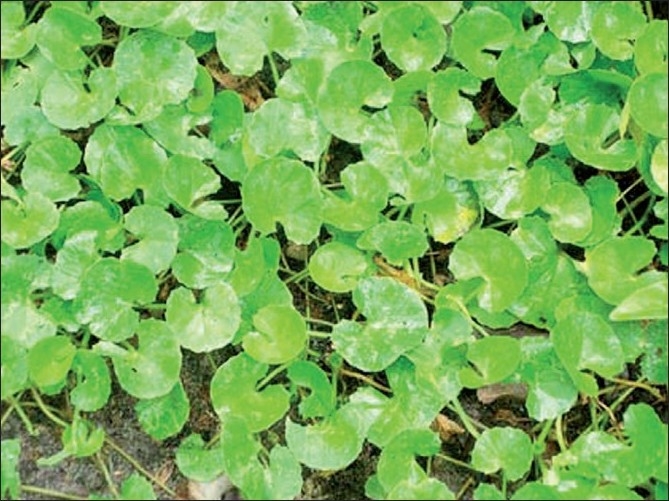 Gotu kola (Centella asiatica) is an important medicinal herb used in Chinese, Ayurvedic and other forms of ancient medicine. Its use is recorded in the Sushruta Samhita, which is an ancient Indian text of medicine. In India the plant is commonly called jal brahmi or mandukaparni (Indian pennywort). In China, the plant is called gotu kola. Scientists refer to the plant using its Latin name, Centella asiatica. The gotu kola plant is a herbaceous creeper and belongs to the Umbelliferae (Apiaceae) family of plants. Other members of this family include celery, parsley and carrots. Gotu kola grows throughout India, Pakistan, Sri Lanka, South Africa, and some parts of Eastern Europe, mainly in tropical and subtropical regions. It is a water loving plant and is both tasteless and odourless to humans. Gotu Kola can grow at high altitudes and possess fan shaped green leaves with white or very light purple flowers. The whole plant is used for its medicinal properties including the leaves and the flowers.
Gotu kola (Centella asiatica) is an important medicinal herb used in Chinese, Ayurvedic and other forms of ancient medicine. Its use is recorded in the Sushruta Samhita, which is an ancient Indian text of medicine. In India the plant is commonly called jal brahmi or mandukaparni (Indian pennywort). In China, the plant is called gotu kola. Scientists refer to the plant using its Latin name, Centella asiatica. The gotu kola plant is a herbaceous creeper and belongs to the Umbelliferae (Apiaceae) family of plants. Other members of this family include celery, parsley and carrots. Gotu kola grows throughout India, Pakistan, Sri Lanka, South Africa, and some parts of Eastern Europe, mainly in tropical and subtropical regions. It is a water loving plant and is both tasteless and odourless to humans. Gotu Kola can grow at high altitudes and possess fan shaped green leaves with white or very light purple flowers. The whole plant is used for its medicinal properties including the leaves and the flowers.
One of the main effects of gotu kola is its ability to decrease wound healing time. Application of gotu kola extract to open wounds on animals results in increased cellular proliferation and increased collagen synthesis in the wound area. There is also an effect to thicken the skin in the area of the wound. Gotu kola may also decrease the inflammation associated with wounds and this effect may occur through the inhibition of free radicals by the antioxidants in gotu kola. Gotu kola may also stimulate the formation of new blood vessels into the damaged tissue. This last effect is interesting as gotu kola has also been shown to improve the strength of veins. The mechanism of this might be through the supply of collagen to the vascular tissue. By improving the strength of the vasculature, the gotu kola may improve the blood flow and the microcirculation in areas of venous insufficiency. Gotu kola may therefore have a balancing effect on connective tissue, allowing regeneration where it is needed without over stimulation.

The active constituents of gotu kola (centella asiatica) are believed to be asiaticosides which are a group of triterpene saponins. These may be similar in structure and function to the ginsenosides in panax ginseng. The asiaticosides may be responsible for the wound healing effects of the plant. Other active constituents include brahmoside and brahminoside which may be responsible for its central nervous system effects. Other components of the plant include plant sterols, flavonoids, tannins, phytosterols, mucilages, resins, amino acids, an alkaloid (hydrochotine), a bitter component (vallerine) and fatty acids. Image is gotu kola plant growing in watery area. Source of image is Gohil et al., 2010.
Central nervous system effects have been described for extracts of gotu kola. These include a mild sedative effect which suggests that gotu kola may act as a tranquilizer. However, at the same time, it has been reported that gotu kola is able to stimulate the central nervous system and may promote improvements in intelligence. Certainly, a mild anxiolytic effect has been described in animal models and it has been speculated that this results from the binding of components of gotu kola to the cholecystokinin receptor. These anxiolytic effects may also be evident in humans. Animal models also suggest that gotu kola has a mild antidepressant effect and this may result from reductions is stress hormone synthesis and increases in serotonin, noradrenaline and dopamine production. Antiepileptic, antioxidant, antinociceptive and antiinflammatory effects have also been described for gotu kola. Therefore gotu kola appears to show properties as a general well being tonic that may improve overall health.
Eat Well, Stay Healthy, Protect Yourself
RdB
